Norway, with its breathtaking fjords, stunning landscapes, vibrant cities, and the elusive Northern Lights, is a destination that captures the imagination of travelers worldwide. Crafting the perfect Norway itinerary to explore all that Norway has to offer in just ten days may seem like a daunting task, but fear not! With careful planning and strategic choices, you can experience the highlights of this Scandinavian gem.
Join us as we map out a dream 10-day Norway itinerary that seamlessly blends natural wonders, cultural experiences, and unforgettable adventures.

Traveling to Norway for the first time can be an exciting and enriching experience· Here are some essential things to know before embarking on your journey.
Table of Contents
Things to Know when Traveling to Norway for the First time:
1. Weather and Seasons:
Norway experiences distinct seasons, with summers being mild and winters cold. The weather can vary greatly depending on the region you’re visiting. Coastal areas have milder winters compared to inland and mountainous regions. Be prepared for changing weather conditions, especially if you’re traveling during the winter months.
2. Language:
The official language of Norway is Norwegian, but many Norwegians speak English fluently, especially in tourist areas. However, learning a few basic Norwegian phrases can be helpful and appreciated by locals. Here are some useful Norwegian phrases to learn:
- Good Morning/Good Evening – God morgen/god kveld
- Yes – Ja
- No – Nei
- Thank you – Takk
- Thank you very much – Tusen Takk
- How are you? – Hvordan har du det?
- I am sorry – Beklager
- You are welcome – Vaer sa god
- Excuse me – Unnskyld meg
3. Currency:
The currency used in Norway is the Norwegian Krone (NOK). Credit and debit cards are widely accepted, but it’s always a good idea to carry some cash for smaller purchases and in case you visit remote areas where card payments may not be available.
4. Transportation:
Norway has an efficient public transportation system, including trains, buses, ferries, and domestic flights. The trains operated by NSB (Norwegian State Railways) connect major cities, while buses cover more remote areas. Consider purchasing a Norway Pass for unlimited travel on trains and buses within a specified period.
5. Cost of Living:
Norway is known for its high cost of living, so be prepared for higher prices compared to other European countries. Budget accordingly for accommodation, dining, and activities.
6. Tpping:
Tipping is not mandatory in Norway, as a service charge is often included in bills at restaurants and hotels. However, it’s customary to round up the bill or leave a small tip if you receive exceptional service.
7. Outdoor Activities:
Norway’s stunning natural landscapes offer numerous outdoor activities such as hiking, skiing, fishing, and wildlife watching. Make sure to pack appropriate clothing and gear, especially if you plan to explore the wilderness or participate in winter sports.
8. Midnight Sun and Northern Lights:
Depending on the time of year and the region you’re visiting, you may experience either the Midnight Sun during the summer months or the Northern Lights (Aurora Borealis) during the winter months. Check the best times and locations for viewing these natural phenomena and plan your trip accordingly.
9. Respect for Nature and Wildlife:
Norway takes environmental conservation seriously, and visitors are expected to respect nature and wildlife. Follow designated trails, avoid littering, and adhere to wildlife protection regulations to help preserve Norway’s pristine landscapes.
10. Emergency Services:
Norway has a well-developed healthcare system and emergency services. The emergency number for police, ambulance, and fire services is 112.
When is the Best time to Visit Norway?
The best time to visit Norway depends on your preferences and the activities you want to experience. Here’s a breakdown of the different seasons and what they offer:
1. Summer (June to August):
- Best for: Midnight Sun, hiking, outdoor activities, festivals.
- During the summer months, Norway experiences the Midnight Sun phenomenon in the northern regions, where the sun remains visible even at midnight· This period offers long daylight hours, making it perfect for outdoor adventures like hiking, camping, fishing, and kayaking.
- The weather is generally mild, with temperatures ranging from 15°C to 25°C (59°F to 77°F) in most areas.
- Summer is also festival season in Norway, with events celebrating music, food, and culture taking place across the country.
2. Autumn (September to November):
- Best for: Fall foliage, fewer crowds, Northern Lights (late autumn).
- Autumn brings stunning displays of fall foliage as the landscapes transform into vibrant hues of red, orange, and yellow.
- The weather starts to cool down, with temperatures ranging from 5°C to 15°C (41°F to 59°F) in most regions.
- Towards the end of autumn, typically from late September to November, you may have the opportunity to see the Northern Lights (Aurora Borealis) in northern areas like Tromsø and Lofoten.
3. Winter (December to February):
- Best for: Northern Lights, winter sports, dog sledding, Christmas markets.
- Winter in Norway is magical, with snowy landscapes and opportunities for winter sports such as skiing, snowboarding, and ice skating.
- The Northern Lights season is in full swing during the winter months, offering excellent chances to witness this natural phenomenon, especially in the northern regions.
- Temperatures vary greatly depending on the region, with coastal areas experiencing milder winters and inland areas being colder. Average temperatures range from -5°C to 5°C (23°F to 41°F) in most regions.
- Christmas markets and seasonal festivities add to the charm of visiting Norway in winter.
4. Spring (March to May):
- Best for: Longer daylight hours, skiing (early spring), blooming flowers.
- Spring brings longer daylight hours and the gradual transition from winter to warmer weather.
- Early spring is still ideal for skiing and other winter sports in many areas.
- As the snow melts, Norway’s landscapes come to life with blooming flowers and budding trees.
- Temperatures start to rise, ranging from 0°C to 10°C (32°F to 50°F) in most regions.
10-Day Norway Itinerary – Norwegian Wonders
Day 1-2: Oslo – Discovering Norway’s Capital
Upon arrival in Oslo, Norway’s vibrant capital, take some time to settle in and adjust to the Norwegian pace of life. Spend your first day exploring iconic landmarks such as the Royal Palace, the Oslo Opera House, and the Vigeland Sculpture Park, where over 200 sculptures by Gustav Vigeland await.
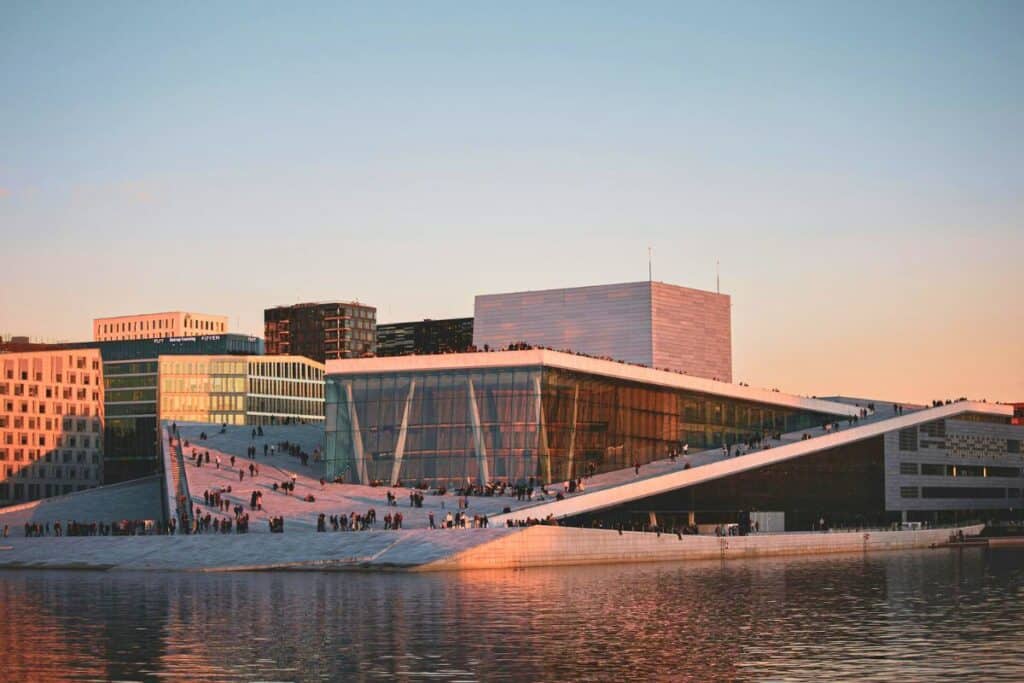
Dive into Norway’s rich history and culture with a visit to the Viking Ship Museum and the National Gallery, home to Edvard Munch’s masterpiece, “The Scream.” In the evening, indulge in traditional Norwegian cuisine at one of Oslo’s top restaurants.
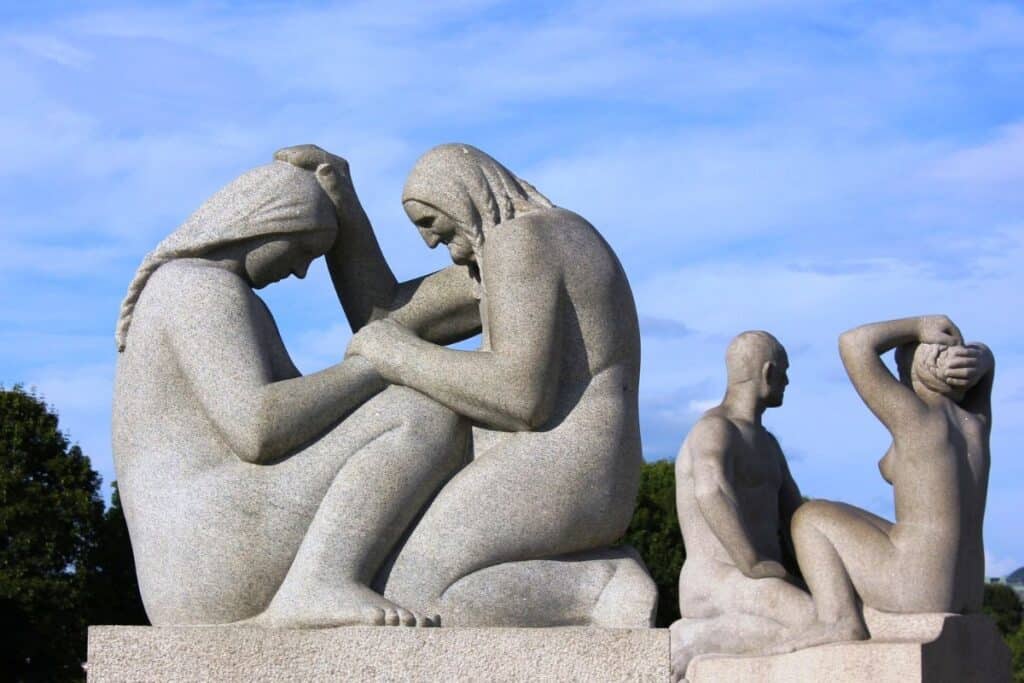
On day two, delve deeper into Oslo’s cultural scene by visiting the Holmenkollen Ski Museum and Jump Tower, offering panoramic views of the city and insights into Norway’s skiing heritage. For a taste of local life, explore the trendy neighborhoods of Grünerløkka and Aker Brygge, dotted with charming cafes, boutique shops, and waterfront promenades.
Where to Stay in Oslo?
- City Center (Sentrum): This area offers convenience and accessibility to major attractions like the Royal Palace, Karl Johans Gate (main shopping street), Oslo Opera House, and museums like the National Gallery. There are various hotels ranging from budget to luxury options.
- Grünerløkka: Known for its trendy vibe, Grünerløkka is filled with hip cafes, bars, boutiques, and street art. It’s a great area for those who prefer a lively atmosphere and want to experience Oslo’s alternative scene. You’ll find a mix of hotels, hostels, and Airbnb options here.
- Frogner: This upscale neighborhood is home to the famous Vigeland Sculpture Park, as well as the Frogner Park and the Nobel Peace Center. It’s a quieter area compared to the city center, with elegant streets and boutique shops· There are several boutique hotels and guesthouses in this area.
- Aker Brygge and Tjuvholmen: Located by the waterfront, Aker Brygge and Tjuvholmen offer picturesque views, upscale dining options, and a vibrant nightlife scene. The area is also home to the Astrup Fearnley Museum of Modern Art. There are luxury hotels and serviced apartments with waterfront views.
- Holmenkollen: If you prefer a more scenic and tranquil atmosphere, consider staying in Holmenkollen. This area is famous for its ski jump and offers outdoor activities like hiking and skiing. There are some hotels and guesthouses with stunning views of the surrounding nature.
- Majorstuen: Situated west of the city center, Majorstuen is a bustling area with shopping streets, cafes, and restaurants. It’s well-connected by public transportation, making it convenient for exploring Oslo. You’ll find a mix of hotels and apartment rentals here.
Day 3-4: Bergen – Gateway to the Fjords
On day three, take a scenic train ride from Oslo to Bergen, known as the gateway to the fjords. Upon arrival, explore Bryggen, the UNESCO-listed Hanseatic wharf, with its colorful wooden buildings dating back to the Middle Ages.
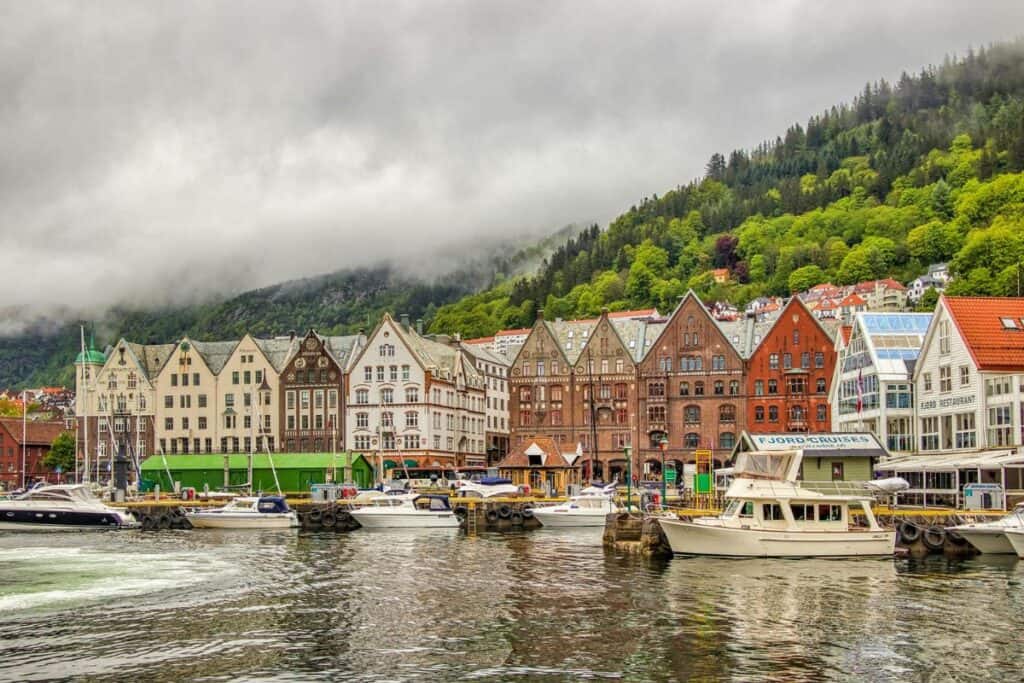
Visit the Fish Market to sample fresh seafood delicacies and embark on a guided walking tour to learn about Bergen’s storied past.
On day four, set sail on a breathtaking fjord cruise through the UNESCO-listed Nærøyfjord and Sognefjord, marveling at cascading waterfalls, sheer cliffs, and snow-capped peaks along the way. Opt for an exhilarating kayaking excursion or hike to panoramic viewpoints for unparalleled photo opportunities.

In the evening, savor traditional Norwegian cuisine at a local restaurant before exploring Bergen’s lively nightlife scene.
Where to Stay in Bergen?
- Bryggen: Staying near Bryggen, the colorful historic wharf area, puts you right in the heart of Bergen’s UNESCO World Heritage site. You’ll be close to many attractions, restaurants, and shops.
- City Centre: Bergen’s city center offers a range of accommodations, from budget hostels to luxury hotels. This area is convenient for exploring the city’s museums, galleries, and dining options.
- Nordnes: Located just a short walk from the city center, Nordnes is a quiet and charming neighborhood with parks, waterfront views, and historic wooden houses. It offers a more relaxed atmosphere while still being close to the main attractions.
- Mount Fløyen: For a unique experience, consider staying near Mount Fløyen. You can take the Fløibanen funicular to reach the top for panoramic views of the city and surrounding mountains. There are also hiking trails and outdoor activities nearby.
- Bergenhus: This area is home to Bergenhus Fortress and the Rosenkrantz Tower, as well as several museums and cultural landmarks. Staying here will give you easy access to these historical sites.
- Near the Waterfront: Bergen’s waterfront area is lined with restaurants, cafes, and bars, offering picturesque views of the harbor and Bryggen. Look for accommodations along Vågen or nearby streets for a scenic stay.
- Outer Neighborhoods: If you prefer a quieter atmosphere away from the tourist crowds, consider staying in one of Bergen’s outer neighborhoods like Sandviken or Årstad. These areas offer a more local vibe and may have cheaper accommodation options.
Day 5-7: Ålesund and Geiranger – Exploring Nature’s Masterpieces
from Bergen to Ålesund, a picturesque coastal town renowned for its Art Nouveau architecture and stunning scenery. Spend your first day strolling through Ålesund’s charming streets, admiring the intricate facades of its historic buildings, and climbing the 418 steps to the top of Mount Aksla for panoramic views of the surrounding islands and fjords.
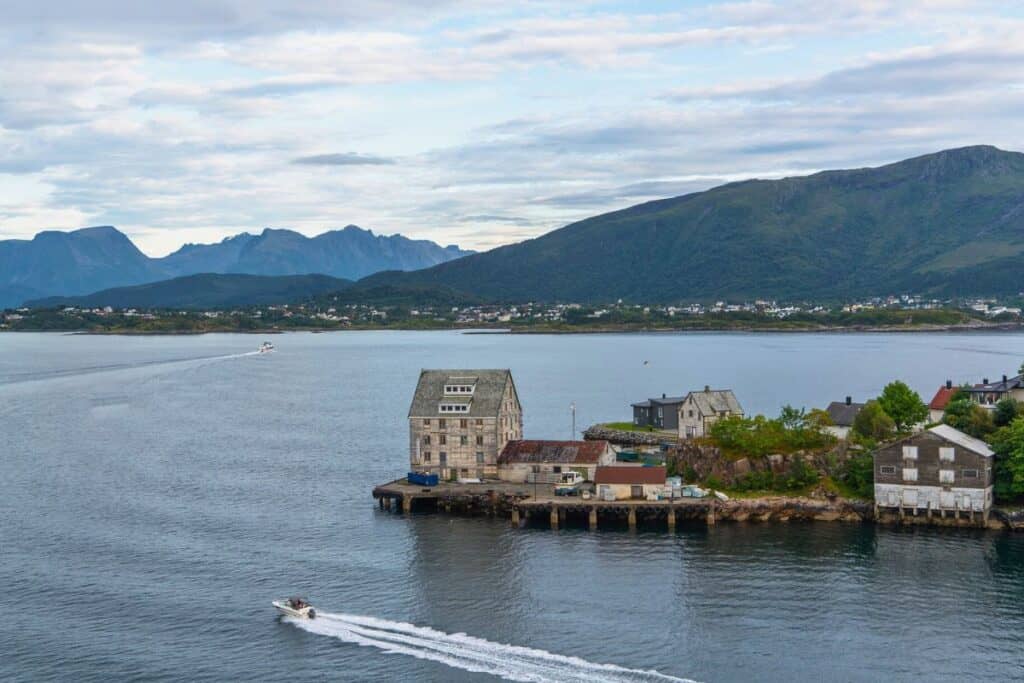
On day six, embark on a scenic drive to Geiranger, a postcard-perfect village nestled at the end of the UNESCO-listed Geirangerfjord.

Explore the fjord’s pristine beauty aboard a sightseeing cruise, passing by iconic landmarks such as the Seven Sisters Waterfall and the abandoned mountain farm of Skageflå. For the ultimate adventure, embark on a thrilling hike to the summit of Dalsnibba Mountain for panoramic views of the fjord below.
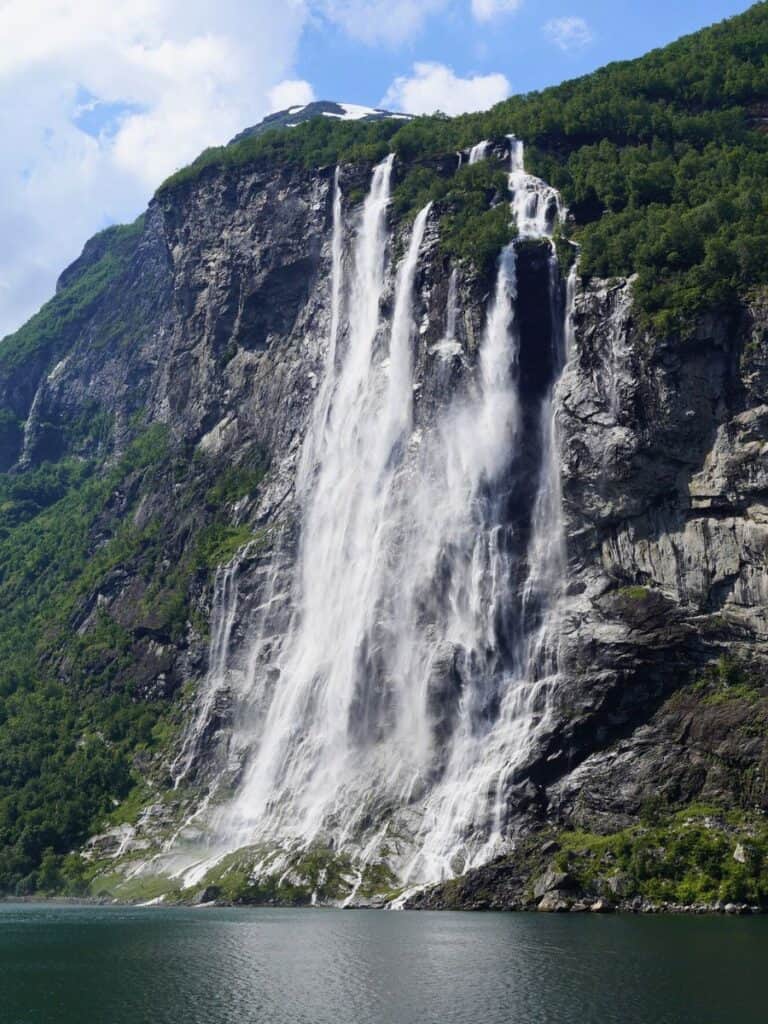
Where to Stay in Ålesund?
- City Center: Staying in the heart of Ålesund puts you within walking distance of attractions, restaurants, and shops. You’ll find hotels ranging from boutique to more well-known chains.
- Waterfront Hotels: Ålesund’s picturesque waterfront is lined with hotels offering stunning views of the harbor and surrounding mountains. These hotels often provide a unique experience with their proximity to the sea.
- Historic Buildings: Some hotels in Ålesund are housed within historic buildings, such as former warehouses or Art Nouveau structures. Staying in one of these properties can add a touch of charm and history to your visit.
- Outer Islands: If you prefer a quieter retreat away from the city center, consider staying on one of the nearby islands. You can find accommodations ranging from cozy guesthouses to upscale resorts, offering a peaceful escape surrounded by nature.
- Airbnb: For a more local experience, consider renting an apartment or house through Airbnb. This option allows you to immerse yourself in the community and often provides more space and amenities than a traditional hotel room.
Day 8-10: Tromsø – Chasing the Northern Lights
Fly from Ålesund to Tromsø, the gateway to the Arctic and one of the best places in the world to witness the mesmerizing Northern Lights. Spend your first day exploring Tromsø’s cultural attractions, including the Arctic Cathedral, Polaria Aquarium, and Tromsø Museum. In the evening, embark on a guided Northern Lights tour, chasing the elusive auroras across the Arctic sky.
Related: An Ultimate Guide to witnessing the Northern Lights in Norway.
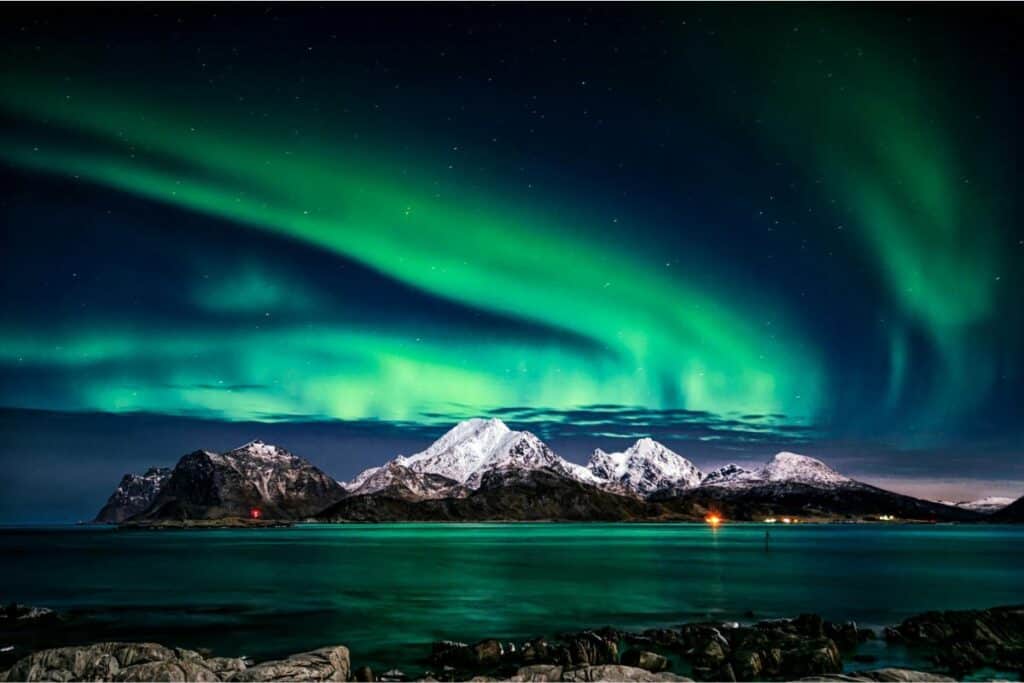
On day nine, immerse yourself in Arctic wilderness with a husky sledding adventure or a reindeer sleigh ride through the snow-covered landscapes surrounding Tromsø. For a truly unforgettable experience, venture into the wilderness on a multi-day dog sledding expedition or a snowmobile safari.
On your final day in Norway, savor the breathtaking beauty of Tromsø one last time before bidding farewell to this enchanting land of fjords and Northern Lights.
Where to Stay in Tromsø?
- City Center: Staying in the heart of Tromsø puts you close to attractions, restaurants, and shops. There are numerous hotels, hostels, and guesthouses within walking distance of the main sights.
- Waterfront: Tromsø is situated on an island, so waterfront accommodations offer beautiful views of the fjords and mountains. Look for hotels or apartments along the harbor for a scenic stay.
- Arctic Cathedral Area: The area around the Arctic Cathedral (Ishavskatedralen) offers a serene atmosphere with stunning views of the city and the Tromsø Bridge. Some hotels in this area provide easy access to nature trails for hiking and skiing.
- Polaria Area: Located near the Polaria Aquarium and the Tromsø Botanic Garden, this area is ideal for families or those interested in nature and wildlife. There are several hotels and guesthouses nearby.
- Budget Accommodations: If you’re traveling on a budget, consider staying in a hostel or guesthouse. Tromsø has several budget-friendly options that offer basic amenities and a communal atmosphere.
- Airbnb: Renting a private apartment or house through Airbnb can be a great option for those looking for more space and privacy. You’ll find a range of properties available throughout the city.
In Conclusion, Crafting your dream 10-day Norway Itinerary is an exhilarating journey of discovery, where every day brings new adventures and unforgettable experiences. From exploring the cultural treasures of Oslo and Bergen to cruising through majestic fjords and chasing the Northern Lights in Tromsø, Norway offers a wealth of wonders waiting to be explored. So pack your bags, embark on this epic Nordic adventure, and create memories that will last a lifetime.
FAQs about Norway itinerary:
What are the must-visit destinations in Norway?
Norway offers breathtaking natural landscapes and vibrant cities· Must-visit destinations include Oslo, Bergen, the fjords (like Geirangerfjord and Nærøyfjord), Lofoten Islands, Tromsø, and the North Cape.
How should I plan my transportation within Norway?
Norway offers efficient transportation options including trains, buses, ferries, and domestic flights. The Norway in a Nutshell tour is a popular choice for experiencing scenic train rides and fjord cruises.
Is it necessary to rent a car to explore Norway?
Renting a car provides flexibility and access to remote areas, especially for exploring the countryside and fjords. However, public transportation is well-developed and sufficient for visiting major cities and tourist attractions.
What should I pack for a trip to Norway?
Pack according to the season and planned activities. Layers are essential, even in summer, as weather can be unpredictable. Don’t forget waterproof clothing, sturdy hiking shoes, a universal adapter, and a camera to capture the stunning landscapes.
How many days should I plan for a trip to Norway?
The ideal duration depends on your interests and the places you want to explore. A comprehensive trip covering major cities and natural wonders might require around 7-10 days. However, even a shorter trip can offer memorable experiences.